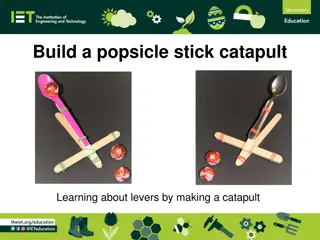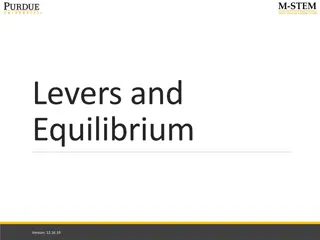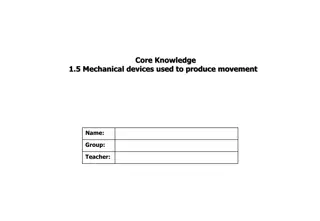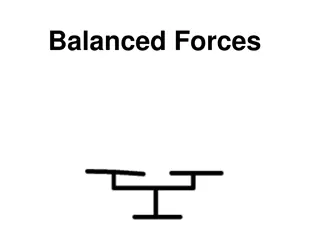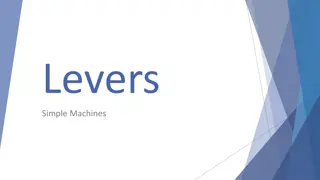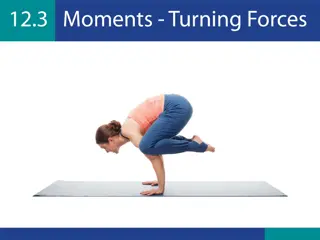Understanding Levers: The Key to Mechanical Advantage
Levers are fundamental mechanical devices that enable the execution of work by producing turning motion around an axis. This article explores the different types of levers, their classifications, and their roles in biomechanics. Understanding levers provides insights into how movement is facilitated in the human body, shedding light on the intricate interplay between muscles, bones, and joints in creating motion.
Download Presentation

Please find below an Image/Link to download the presentation.
The content on the website is provided AS IS for your information and personal use only. It may not be sold, licensed, or shared on other websites without obtaining consent from the author. Download presentation by click this link. If you encounter any issues during the download, it is possible that the publisher has removed the file from their server.
E N D
Presentation Transcript
Lever is a mechanical device to produce turning motion about an axis. Lever is one of the simple machine device for execution of work. It is a rigid bar moving around a fixed point of axis force should be applied to move it ,the resistance should be overcome.
Since they are 3 Points, there are 3 possibilities of arrangement- Any one of three may be situated between other Two. The arrangement of these three points provide the basis for classification-: Class I Lever Class II Lever Class III Lever
In a first-class lever the fulcrum is between the effort and resistance, where the lever exerts a force. In a second-class lever the resistance is between the fulcrum and effort. For such levers, if the effort arm is longer than the resistance arm, less effort over a certain distance exerts a greater force over a shorter distance. In a third-class lever the effort is between the fulcrum and resistance. More effort is required to move less weight, but the speed and distance moved are increased.
A lever system is a rigid bar that moves on a fixed point called the fulcrum when a force is applied to it. Movement is made possible in the human body by lever systems that are formed by our muscles and joints working together. An understanding of the levers in the body helps us to understand how movement is possible. Levers in biomechanics Muscles are attached to bones via tendons and the bones of the skeleton act as levers which muscles pull on to create movement. A lever system is made up of three parts; an effort, a load, and a fulcrum. In the human body, the effort is provided by the muscle (the muscles point of application/insertion), the load is the weight of the body and any additional resistance and the fulcrum is the joint itself.
There are three types found in the body, each is determined by the relative positions of the fulcrum (F), effort (E) and load (L). A useful way of determining the different types of lever systems operating during a particular movement is to remember the following rhyme. For a first-class lever, F is the middle component. For a second class lever, L is the middle component. For a third-class lever, E is the middle component.
Lever systems have two main functions; firstly to increase the resistance that a given force can move and secondly to increase the speed at which a body moves. In addition, different types allow different ranges of movement. This means that some are effective at overcoming resistance, whilst others are able to generate speed.
In a first-class lever, the fulcrum is the middle component and lies between the effort and load. Examples of a first-class lever in the body are rare as few exercises utilise a first-class lever system although extension (straightening) at the elbow is one example. Extension at the elbow can be seen during a throwing action or tennis stroke. In the image below, the triceps is the effort, the fulcrum is the elbow joint and the load is the weight of the arm and Javelin. First-class levers increase both the effects of effort and the speed of the body. There is sometimes more than one lever system operating at the joint. The elbow joint is one example. During extension of the elbow, the effort is created by the triceps via its point of insertion on the ulna, so is a first-class lever. However, during flexion at the elbow, as in a bicep curl, the effort comes from the point of insertion of the biceps on the radius, this is an example of a third-class system.
In a second class lever system, the load is the middle component and lies between the fulcrum and the effort. Exercises involving plantar flexion at the ankle (going up on your toes) are second class lever systems, such as a calf raise or when jumping upwards whilst performing a layup in basketball. Second class lever systems only tend to increase the effect of the effort force, in other words, they are effective at overcoming resistance as opposed to generating speed. In the example of plantar flexion at the ankle joint, the ball of the foot and toes are the fulcrum, the weight of the body is the load and the effort is applied by the gastrocnemius muscle.
The majority of movements in the human body are classified as third-class lever systems. In a third- class lever system, the effort is the middle component and lies between the fulcrum and load. There are many examples of third class lever systems, including both flexion and extension at the knee joint. These movements are involved in running, jumping and kicking. During flexion at the knee, the point of insertion of the hamstrings on the tibia is the effort, the knee joint is the fulcrum and the weight of the leg is the load. Third class lever systems are used to increase the speed of a body and allow a wide range of movement.





